
USGS/Cascades Volcano Observatory, Vancouver, Washington
CVO Photo Archives -
Miscellaneous Monitoring Images
-
 [Image,43K,JPG]
[Image,43K,JPG]
A "bulge" developed on the north side of Mount St. Helens as magma pushed up
within the peak. Angle and slope-distance measurements to the
bulge indicated it
was growing at a rate of up to five feet (1.5 meters) per day.
By May 17, part of the
volcano's north side had been pushed upwards and outwards over
450 feet (135 meters).
The view is from the northeast.
-- USGS Photo by Peter W. Lipman, April 27, 1980
-
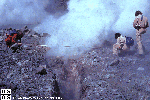 [Image,69K,JPG]
[Image,69K,JPG]
The U. S. Geological Survey has established both periodic and continuous 24-hour
monitoring programs of Mount St. Helens to study and predict eruptions. In this
slide, geologists use a steel tape to measure the distance across a crack on the
crater floor. Widening of cracks is an indication that magma is rising and
deforming the area, leading to an eruption. These cracks are generally
radial to the dome, like spokes of a wheel.
-- USGS Photo by Lyn Topinka, May 12, 1981
-
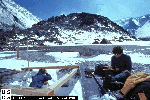 [Image,82K,JPG]
[Image,82K,JPG]
Geologists use a theodolite and EDM (Electronic Distance Meter) to measure angles
and slope-distances to the lava dome. Changes in these angles and distances are
used to calculate "deformation rates". An increase in deformation rates is an
indication that magma is slowly entering the dome.
Deformation rates often reach
30 feet per hour (10 m/hr) as magma rises and the dome expands before extrusion
starts. During the winter months, the instrument stations often
have to be dug out
of the snow before measurements can be made.
-- USGS Photo by Lyn Topinka, May 26, 1984
-
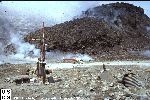 [Image,89K,JPG]
[Image,89K,JPG]
Geologists install a seismic station near the dome. The U.S. Geological Survey,
in conjunction with the University of Washington, maintains seismic stations at
Mount St. Helens. An increase in seismicity (earthquakes) is often the first
precursor to an approaching eruption.
-- USGS Photo by Eugene Y. Iwatusbo, August 4, 1981
-
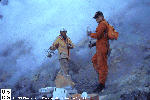 [Image,54K,JPG]
[Image,54K,JPG]
Geologists collect gas samples around the dome. Samples are gathered from vents
on the dome and crater floor, and are used to monitor changes in chemical
composition. Additionally, sulfur dioxide gas is measured
from specially-equipped
airplane before, during, and after eruptions to determine "emission rates" for
the volcano. During eruptions, emission rates typically increase to 5 to 10
times their pre-eruptive value.
-- USGS Photo by Thomas J. Casadevall, September 24, 1981
-
 [Image,100K,JPG] ...
[Image,60K,JPG]
[Image,100K,JPG] ...
[Image,60K,JPG]
COSPEC setup on Sugar Bowl (northwest flank of Mount St. Helens) to measure
SO2 emissions from top of dome.
-- USGS Photo by Lyn Topinka, October 21, 1983
-
 [Image,66K,JPG]
[Image,66K,JPG]
Geologists measure the strength of the magnetic field surrounding the dome. The
strength of the field increases as the dome cools and magnetic minerals form.
During the eruptions the strength usually changes rapidly
as magma heats and deforms the dome.
-- USGS Photo by Lyn Topinka, June 18, 1984
-
 [Image,101K,JPG]
[Image,101K,JPG]
Geologists do precise leveling to measure changes in the slope of the
crater floor, due to moving magma. Changes in slope are also measured
electronically by tiltmeters. Tiltmeters allow 24-hour monitoring as the information
is telemetered back to CVO. Other instruments such as displacement meters for measuring
cracks, seismometers for measuring earthquakes,
gas sensors for measuring gas concentrations, and
magnetometers for measuring the magnetic field,
are also used for 24-hour monitoring.
-- USGS Photo by Holly Martinson, May 1982
-
 [Image,79K,JPG]
[Image,79K,JPG]
In 1983, the U. S. Geological Survey extended both its periodic and
its 24-hour monitoring programs to the top of Mount St. Helens' dome.
In this aerial view, three geologists (middle bottom) are busy taking
measurements to determine deformation rates.
-- USGS Photo by Lyn Topinka, April 18, 1988
-
 [Image,57K,JPG]
[Image,57K,JPG]
The U. S. Geological Survey also maintains a network of monitoring
stations around the base of Mount St. Helens. Angle and distance
measurements to the volcano's flanks are taken periodically to watch
for any deformation similar to the 1980 bulge. Pictured here is an
instrument station northeast of the volcano.
-- USGS Photo by Lyn Topinka, May 15, 1989
-
 [Image,44K,JPG]
[Image,44K,JPG]
Geologists use a theodolite and EDM to
measure angles and slope-distances from Harrys Ridge (5 miles to
the north) to Mount St. Helens crater and lava dome, 1981
-- USGS Photo by Lyn Topinka, October 31, 1981
-
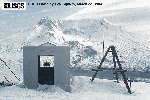 [Image,44K,JPG]
[Image,44K,JPG]
Geologists measure angles and slope-distances from Harrys Ridge (5 miles to
the north) to Mount St. Helens crater and lava dome, 1984
-- USGS Photo by Lyn Topinka, March 22, 1984
-
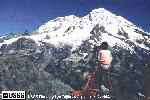 [Image,54K,JPG]
[Image,54K,JPG]
Deformation monitoring at Mount Rainier, using helicopter and EDM.
-- USGS Photo by Lyn Topinka, September 12, 1983
-
 [Image,86K,JPG]
[Image,86K,JPG]
USGS Spirit-Level tilt measurements at Mount Rainier.
Using a triangular system of benchmarks, changes in the ground
surface are recorded.
-- USGS Photo by Lyn Topinka, 1983
-
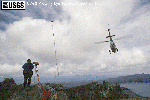 [Image,29K,JPG]
[Image,29K,JPG]
Establishing baselines, deformation monitoring, Newberry Caldera.
-- USGS Photo by Lyn Topinka, August 20, 1985
-
 [Image,305K,GIF]
[Image,305K,GIF]
Global Positioning System (GPS) receiver at Cotopaxi Volcano, Ecuador. GPS uses data transmitted by orbiting
satellites to locate points on the ground. The USGS has made baseline GPS measurements at several volcanoes in the
United States and in Latin America. In the event of an awakening of one of these volcanoes, GPS receivers would be
set up at these points again to determine whether or not measurable deformation had occurred and to monitor for
precursory deformation that might herald an eruption.
-- USGS Photo by J. W. Ewert
-
 [Image,107K,JPG]
[Image,107K,JPG]
Global Positioning System (GPS) setup, Mears, Oregon.
-- USGS Photo by Ken Yamashita, 1997
-
 [Image,488K,GIF]
[Image,488K,GIF]
Acoustic Flow Monitor (AFM) site in the Drift River valley, near Redoubt Volcano, Alaska. The key component of
the AFM system is a seismometer, buried in the ground nearby, that responds to the high-frequency (10-300 Hz)
vibrations that characterize lahars. Inspired by the Nevado del Ruiz tragedy in 1985, the AFM system was
developed and tested at Mount Redoubt, and then successfully used in the Philippines to monitor lahars at Mount
Pinatubo.
-- USGS Photo by S. R. Brantley
-
 [Image,100K,JPG] ...
[Image,60K,JPG]
[Image,100K,JPG] ...
[Image,60K,JPG]
COSPEC setup on Sugar Bowl (northwest flank of Mount St. Helens) to measure
SO2 emissions from top of dome.
-- USGS Photo by Lyn Topinka, October 21, 1983
-
 [Image,42K,JPG]
[Image,42K,JPG]
Fumarole sampling at Mount Baker's summit.
-- USGS Photo by Thomas J. Casadevall
-
 [Image,72K,JPG]
[Image,72K,JPG]
Fumarole sampling, Mount Mageik, Alaska
-- USGS Photo by Bea Ritchie, July 1995
-
 [Image,131K,GIF]
[Image,131K,GIF]
Seismogram from Garden Seismic Station,
showing an increase in earthquakes during a dome-building
eruption of Mount St. Helens.
-- USGS Photo by Lyn Topinka
-
 [Image,175K,GIF]
[Image,175K,GIF]
Seismograph in action at Pinatubo response. Signals from some seismometers are always recorded on analog drum
recorders. Despite advances in computer-based data acquisition, drum recorders are still needed. A glance at the
seismogram wrapped around the drum gives experienced volcanologists a quick appreciation of the current level of
seismic activity at the volcano.
-- USGS Photo by R. P. Hoblitt
-
 [Image,285K,GIF]
[Image,285K,GIF]
Response to the Mount Pinatubo crisis in the Philippines. USGS and PHIVOLCS personnel install a seismic station
near Mt. Pinatubo six weeks before the devastating eruptions. Installation of a monitoring network is a team effort.
-- USGS Photo by J. A. Power
-
 [Image,235K,GIF]
[Image,235K,GIF]
55-gallon barrel drum used as a
short-term camera mount during an eruption of
Mount St. Helens. The drum was flown empty out to the volcano and then
filled with rocks, a tripod head was secured to the lid, and the camera's
protective metal housing was attached to the tripod head.
-- USGS Photo by Lyn Topinka
-
 [Image,16K,JPG]
[Image,16K,JPG]
Photographing Mount St. Helens gas and ash plumes, from Sugarbowl.
-- USGS Photo by Lyn Topinka, 1983
-
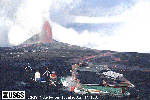 [Image,149K,GIF]
[Image,149K,GIF]
Monitoring Pu'u O'o eruption, Hawaii.
-- USGS Photo by Lyn Topinka, April 1986
-
 [Image,80K,JPG]
[Image,80K,JPG]
Gage house at Coldwater Lake
-- USGS Photo by Lyn Topinka, October 1, 1982
-
 [Image,111K,JPG]
[Image,111K,JPG]
Gage house at Tower Road with telemetry equipment
-- USGS Photo by Lyn Topinka, September 3, 1985
-
 [Image,62K,JPG]
[Image,62K,JPG]
PS69 sampler in gage house at Tower Road
-- USGS Photo by Lyn Topinka, September 3, 1985
-
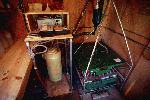 [Image,67K,JPG]
[Image,67K,JPG]
Dynatrol and PS69 sampler in gage house at Tower Road
-- USGS Photo by Lyn Topinka, June 2, 1987
-
 [Image,118K,GIF] ...
[Image,118K,GIF] ...
Sediment sampling from bridge structure
-- USGS Photo by Lyn Topinka, June 2, 1987
-
 [Image,196K,GIF]
[Image,196K,GIF]
Stream gaging with tag line
-- USGS Photo by Lyn Topinka, April 27, 1985
-
 [Image,157K,GIF]
[Image,157K,GIF]
River channel cross-section surveying -
view here
is of the North Fork Toutle River drainage,
on north side of Mount St. Helens.
Drainage has eroded into the blast deposits.
-- USGS Photo by Lyn Topinka
-
 [Image,108K,GIF]
[Image,108K,GIF]
River channel cross-section surveying -
view here
is at Pine Creek drainage, on south side of the volcano's base.
Ash covers the ground surface. Mount St. Helens is in the distance.
-- USGS Photo by Lyn Topinka
-
 [Image,80K,JPG]
[Image,80K,JPG]
River channel cross-section surveying -
view here
is along the Muddy River drainage, approximately one mile (1.5 kilometers)
southeast of the volcano's base. Rod person (lower left) and
instrument persons (upper right) give scale.
-- USGS Photo by Lyn Topinka, June 26, 1981
Return to:
[CVO Photo Archives Menu] ...
[Volcano and Hydrologic Monitoring Menu] ...

Use of CVO Material and Copyright Information
URL for CVO HomePage is:
<http://vulcan.wr.usgs.gov/home.html>
URL for this page is:
<http://vulcan.wr.usgs.gov/Photo/Monitoring/images.html>
If you have questions or comments please contact:
<GS-CVO-WEB@usgs.gov>
03/25/02, Lyn Topinka
 Use of CVO Material and Copyright Information
Use of CVO Material and Copyright Information

 Use of CVO Material and Copyright Information
Use of CVO Material and Copyright Information
 [Image,43K,JPG]
[Image,43K,JPG]
 [Image,69K,JPG]
[Image,69K,JPG]
 [Image,82K,JPG]
[Image,82K,JPG]
 [Image,89K,JPG]
[Image,89K,JPG]
 [Image,54K,JPG]
[Image,54K,JPG]
 [Image,100K,JPG] ...
[Image,60K,JPG]
[Image,100K,JPG] ...
[Image,60K,JPG]
 [Image,66K,JPG]
[Image,66K,JPG]
 [Image,101K,JPG]
[Image,101K,JPG]
 [Image,79K,JPG]
[Image,79K,JPG]
 [Image,57K,JPG]
[Image,57K,JPG]
 [Image,44K,JPG]
[Image,44K,JPG]
 [Image,44K,JPG]
[Image,44K,JPG]
 [Image,54K,JPG]
[Image,54K,JPG]
 [Image,86K,JPG]
[Image,86K,JPG]
 [Image,29K,JPG]
[Image,29K,JPG]
 [Image,305K,GIF]
[Image,305K,GIF]
 [Image,107K,JPG]
[Image,107K,JPG]
 [Image,488K,GIF]
[Image,488K,GIF]
 [Image,100K,JPG] ...
[Image,60K,JPG]
[Image,100K,JPG] ...
[Image,60K,JPG]
 [Image,42K,JPG]
[Image,42K,JPG]
 [Image,72K,JPG]
[Image,72K,JPG]
 [Image,131K,GIF]
[Image,131K,GIF]
 [Image,175K,GIF]
[Image,175K,GIF]
 [Image,285K,GIF]
[Image,285K,GIF]
 [Image,235K,GIF]
[Image,235K,GIF]
 [Image,16K,JPG]
[Image,16K,JPG]
 [Image,149K,GIF]
[Image,149K,GIF]
 [Image,80K,JPG]
[Image,80K,JPG]
 [Image,111K,JPG]
[Image,111K,JPG]
 [Image,62K,JPG]
[Image,62K,JPG]
 [Image,67K,JPG]
[Image,67K,JPG]
 [Image,118K,GIF] ...
[Image,118K,GIF] ...
 [Image,196K,GIF]
[Image,196K,GIF]
 [Image,157K,GIF]
[Image,157K,GIF]
 [Image,108K,GIF]
[Image,108K,GIF]
 [Image,80K,JPG]
[Image,80K,JPG]
